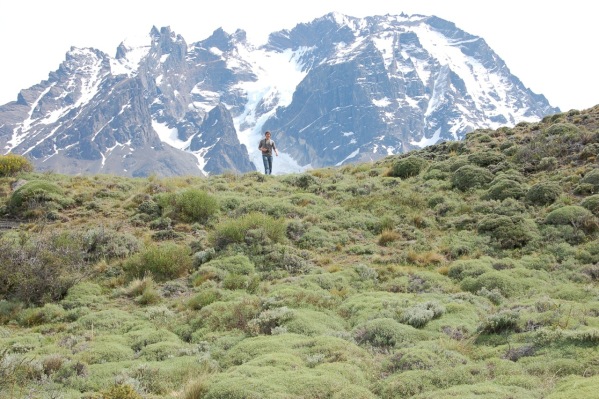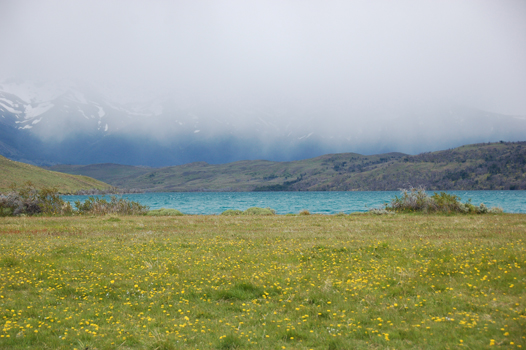"This powerful film odyssey across America explores the sea change in our national attitude from pride in big dams as engineering wonders to the growing awareness that our own future is bound to the life and health of our rivers. Dam removal has moved beyond the fictional Monkey Wrench Gang to go mainstream. Where obsolete dams come down, rivers bound back to life, giving salmon and other wild fish the right of return to primeval spawning grounds, after decades without access. DamNation’s majestic cinematography and unexpected discoveries move through rivers and landscapes altered by dams, but also through a metamorphosis in values, from conquest of the natural world to knowing ourselves as part of nature."
SUNDAY PALEO / April 22, 2012
Everyday should be Earth day. Patagonia.
FITNESS
Backwoods Workouts With the World’s Fittest Man
"Erwan Le Corre doesn’t care for treadmills or pumping iron. He gave up karate long ago and lost interest in playing soccer. Nor does yoga, yin to the yang of the weight room, hold much appeal for the 40-year-old Frenchman. Yet Le Corre is built like a track star and can climb a tree as quickly as cat. He is also is adept at carrying logs, tossing rocks, scaling cliffs, slogging through mud pits and wrestling." - Smithsonian.com
MODERN DISEASES
Daily Soda Consumption Increases Stroke Risk
"In the study, men and women who consumed one or more sugar-sweetened sodas per day were 16 percent more likely to have a stroke over a 20- to 30-year period, compared with those who drank no soda." - MyHealthNewsDaily Staff
Omega-3 Polyunsaturated Fatty Acids: Mechanisms and Clinical: n-3 PUFAs; The Potential for Atherosclerotic Plaque Stability
"The n-3 PUFAs have been shown to exert a range of anti-inflammatory actions, he said, which include decreased production of arachidonic acid-derived prostaglandins and leukotrienes, decreased production of inflammatory cytokines, decreased expression of adhesion molecules and decreased expression of degrading proteinases that can erode plaque caps." - Medscape
NUTRITION
Eat Like A Caveman: Nutrition Lessons From The Paleolithic Era
"Paleo diet–approved foods are high in soluble fiber, antioxidants, phytochemicals, omega-3 and monounsaturated fats and low-glycemic carbohydrates—the kind of nutrients that allowed our ancestors to have strong, lean and active bodies." - Wellness Times
Teach Kids to Read “High Fructose Corn Syrup” in Ingredient Lists
"So off to the candy aisle we went. We walked out of the store with a bottle of Mellow Yellow because it was cheap and the print was bigger. In case you don’t know what that is – I certainly didn’t – it’s a lemon soda that contains nothing but poisonous substances. If you try this experiment at home, whatever you do, don’t open that bottle!" - The Primal Parent
PALEO RECIPES
- Paleo Shrimp and Whitefish Ceviche, A Chilled Snack with Ginger
- Two Minute Tuna Salad
- Sweet BBQ Baby Back Ribs (and instructions for a DIY wood-fired grill)
TRANSPORTATION
In the market for an electric car? Check out the new Ford Focus here and here. Or, maybe you want to wait for the Sora electric motorcycle by Lito Green Motion; video here.
URBAN FARMING
Urban farming is reaching a new level. Not only are communities, such as Boise, increasingly embracing the concept, its benefits beyond food, such as in Green Gotham, are also increasingly being recognized. Now Michigan is proposing a “100-acre, $100-million urban-farming research center in Detroit” and Colorado State University is hiring its “first urban agriculture extension agent.”
Find a brief survey of urban farming in cities throughout the world here. Some people are even being salaried for their efforts.
FROM THE ARCHIVE
Hiking in Torres del Paine National Park
Technically an offshoot of walking, this is my personal favorite way to Move Frequently at a Slow Pace. There’s nothing wrong with walking around the block with my wife at sunset (in fact, there’s everything right with it), but there’s just something about being out in nature, mostly alone and free to do as I please. And really, is there anything more Primal than messing around in the open wilderness? The terrain shifts, there are rocks to lift and toss, tree limbs to climb, and hills to scale. Because your foot lands differently on varied terrain, you train the small muscles in your feet more effectively. If walking around your placid suburban block gets old, strike out for the hills!
Mark Sisson on hiking
Primal Blueprint Fitness
Although we did not lift heavy rocks or climb trees, the hikes in Torres del Paine National Park in Patagonia, Chile were beautiful and invigorating. Here are a few photos.
Rafa, one of our guides, and John Michael.
John Michael and guide Nata.
Previous trip entries in chronological order:
- Travel - Chile / Patagonia, November 2011
- November 10: Arrival in Santiago, Chile
- Book fair in converted rail station, Santiago
- Terminal del Sur, Santiago
- John Michael at Terminal del Sur, Santiago
- Churrasco al Plato con Huevos
- Internet caffe, bus terminal Puerto Montt
- Boarding a Navimag Ferry
- November 11: On Navimag
- View along the port
- View of Puerto Montt & 32 person lifeboat
- John Michael: Voyage by Sea
- November 12 - Channels, Fjords & the Pacific
- November 13: Puerto Eden and the Pio Once Glacier
- November 14 & 15: Puerto Natales
- November 15-20: EcoCamp
- November 15: Hiking the French Valley, Torres del Paine National Park
November 15: Hiking the French Valley, Torres del Paine National Park

The first hikers in Chile came by boat. Nomadic clans from Siberia crossed Beringia - the landmass that connected Asia to Alaska - 15 to 18 thousand years ago. They likely travelled south along the west coast of North and South America using small boats and living on seafood, waterfowl, and caribou. These Paleo-Americans reached southern Chile 14,600 thousand years ago and steadily moved inland, some inhabiting the Milodon Cave (Cueva del Milodon) in Patagonia 12,000 years ago.
Today, almost 15,000 years following the arrival of the first Paleo Americans, the same rhythm seems to be at work. A boat takes you to another point on the land and exploration continues by walking, hiking, or trekking. Both means of travel provide a deep sense of connection to the natural wonder of southern Chile. The modern world, however, still shows it presence: Torres del Paine National Park is so large, reaching the trailheads usually requires a hydrocarbon burning boat or road vehicle.
Following dinner in the EcoCamp dinning dome, our expert guides reviewed the two hiking options for the coming day. All nine members of our group selected the French Valley hike. My son and I packed a Paleo lunch in a Tupperware-style container and small backpacks containing a camera, outerwear, snacks, and one bottle of water - our guides advised us the natural spring water was drinkable. Obviously, talk to your guide and make your own decision.

View of Los Cuernos (The Horns) from the boat.
November 12 - Channels, Fjords & the Pacific
By Dr. John
This is the 13th entry of our recent trip to Chile. A list of all the previous trip posts is below.
Breakfast the next day was a greater challenge: yogurt, porridge, and coffee or juice. I regret eating the porridge - the first time I have eaten rice in over a year - and sense some sluggishness minutes later. (Be prepared, you can't bring everything you eat, but it's good to have some back-up.) Fortunately, two pears finish the breakfast just fine.
The Navimag boat takes us along a channel heading south from Puerto Montt as it makes its way to Puerto Natales. After traveling along multiple islands and fjords, at 4 pm we enter Bahia Anna Pink, a bay opening into the Pacific, and sail a 12-hour segment along the Pacific coast and through the Golfo de Penas (Gulf of Punishment).
During one of his charlas (briefings) the ship's guide shares his thoughts about the ocean pass: "If the weather is good, the boat will move. If the weather is bad, the boat will move." The implication is clear. We enter the Pacific in mild to moderate weather: overcast misty sky and a grey rolling swells covered with wind blown chop. There are fewer people in the dinning room that evening.
Previous trip entries in chronological order:
- Travel - Chile / Patagonia, November 2011
- November 10: Arrival in Santiago, Chile
- Book fair in converted rail station, Santiago
- Terminal del Sur, Santiago
- John Michael at Terminal del Sur, Santiago
- Churrasco al Plato con Huevos
- Internet caffe, bus terminal Puerto Montt
- Boarding a Navimag Ferry
- November 11: On Navimag
- View along the port
- View of Puerto Montt & 32 person lifeboat
- John Michael: Voyage by Sea
Patagonia, the new local economy, and fabric recycling
Yesterday I took the day off. Yes, in the middle of the week, unusual. I drove to Boulder and took an easy hike in Chautauqua Park at the Flatirons base, my first hike since the cycling injury. After lunch, I strolled along Pearl Street and stopped into the Patagonia store. One of the first things to catch my eye was the book let my people go surfing: the education of a reluctant businessman by Patagonia founder Yvon Chouinard.
In the Preface, Yvon lays out new directions for Patagonia brought on through reflections on sustainability:
At Patagonia we have started to prepare for what we think will become a more locally based economy. A global economy based on cheap transportation is not sustainable. Our present mode of production includes buying organic cotton in Turkey, shipping the bales to Thailand to be processed into fabric, shipping the fabric to Texas to be cut, to Mexico to be sewn, on to our warehouse in Reno, then to our stores and dealers, and finally to our customers' homes.
The retail price of regular gas 10 years ago (May 8, 2001) was $1.427 per gallon. Today it is $3.963. If petroleum prices continue to increase at same rate over the next couple of decades, it wont be sustainable at all.
Another direction for Patagonia is to "start making all clothing from recycled and recyclable fibers." This is a dramatic change, one that will likely take years, and may never fully materialize. But for a company already a leader in sustainability, it signals a new direction that other companies will likely emulate. Beginning with the Common Threads Recycling Program:
We seek to close the manufacturing and consumption loop in the way the modern aluminum industry works. We'll collect from our customers their worn out polyester garments and send them back to Teijin for recycling into new polyester fiber. ...With the extra shipping, the program still yields energy savings of 76% and reduction in greenhouse-gas (CO2) emissions of 71 percent, compared to the creation of polyester fiber from new, petroleum based raw material.
Those savings are sure to generate interest among competitors. However, as always, customer choices drive the market.
Related entries:












